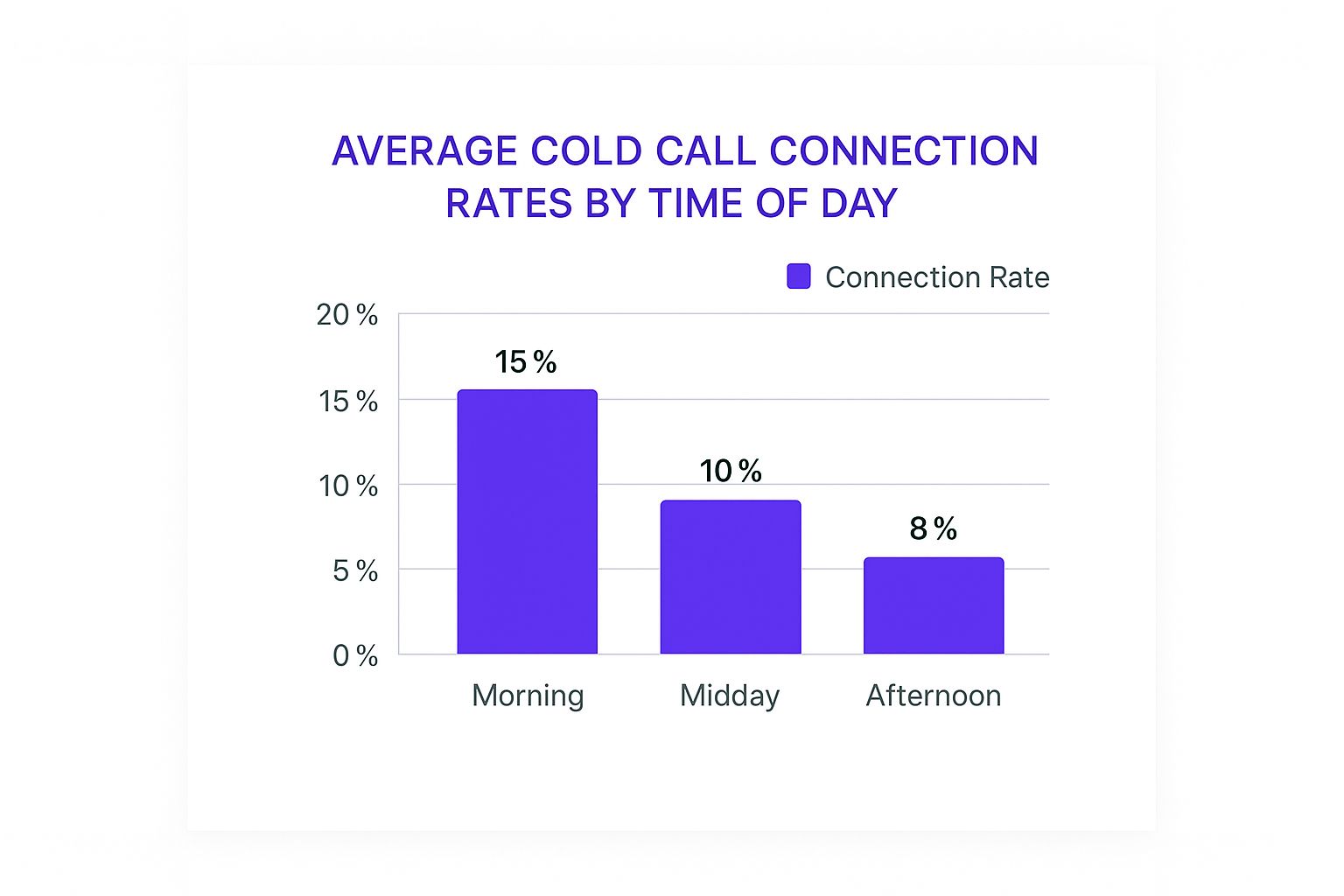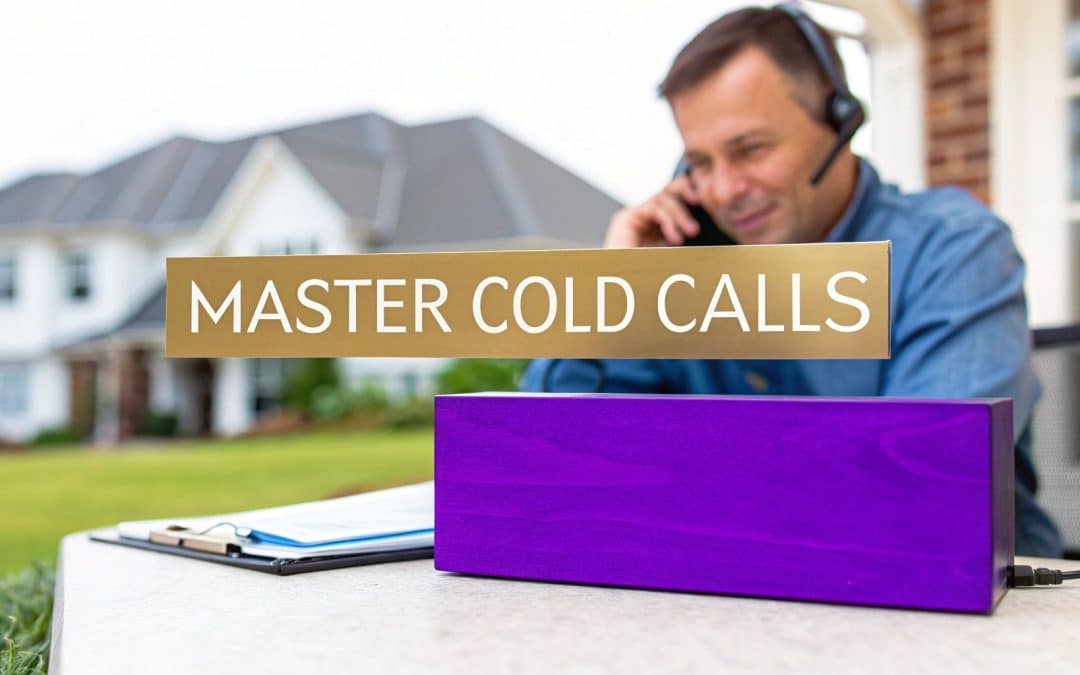Let's be real—making cold calls can feel like a thankless chore. Homeowners are notoriously good at screening calls, and sometimes just getting a live person on the phone feels like winning the lottery. But here's the thing: cold calling still works for proactive home service businesses. You just have to ditch the old, pushy tactics and adopt a smarter, more modern approach.
Why Bother With Cold Calls in a Digital World?
I get it. The thought of dialing up a total stranger can be intimidating, especially when we have digital ads and social media leads. It feels old-school. But for home service pros—think HVAC, plumbing, roofing, or landscaping—it has one massive advantage: it lets you create demand instead of just waiting for it to show up.
Think about it. Your online marketing efforts are great for catching homeowners who are already searching for a solution. They have a leaky pipe or a broken AC and they need help now. Cold calling, on the other hand, lets you connect with people who need your services but haven't started looking yet. This is your secret weapon for booking seasonal tune-ups or filling the schedule during those notoriously slow months.
The Reality Check: Navigating Today's Challenges
Of course, it’s not all sunshine and signed contracts. You have to go into this with your eyes wide open. Connection rates can be tough, and you need to be mentally prepared for that. The industry-wide success rate often hovers around a slim 2%, which really underscores how hard it is to turn a cold lead into a customer these days.
A huge part of that challenge is that an estimated 87% of Americans simply don't answer calls from unknown numbers. To make matters worse, around 80% of those calls go straight to voicemail, and we all know how often those get returned. You can dig into more data on cold calling difficulties to get the full picture.
But don't let those numbers scare you off. They're meant to set realistic expectations, not discourage you. Winning at modern cold calling isn't about mindlessly dialing hundreds of numbers. It’s about being precise, strategic, and making every single conversation count.
The goal isn't just to make more calls; it's to start more conversations. A great cold call offers immediate value and establishes you as a helpful local expert, not just another pushy salesperson.
The data below highlights a few key tactics that can significantly shift the odds in your favor. These aren't just theories; they are practical adjustments that turn a frustrating dial-a-thon into a genuine opportunity to connect with potential customers.
Key Factors That Boost Cold Call Success Rates
| Tactic | Potential Impact on Success Rate | Example Application for Home Services |
|---|---|---|
| Hyper-Local Targeting | Calling within a specific area where you've worked can increase relevance and trust. | "Hi, this is Mike from A+ Roofing. We just finished a roof replacement for your neighbor, the Johnsons, at 123 Maple Street and wanted to offer a free storm damage inspection while we're in the area." |
| Compelling Call Reason | Having a specific, timely offer instead of a generic introduction improves engagement by 2-3x. | "With the recent hailstorm, we're offering homeowners on Elm Street a complimentary gutter and siding check this week only." |
| Personalization | Mentioning a relevant detail or showing empathy can make the call feel less robotic and more human. | "I know I'm calling out of the blue, but as a fellow homeowner in this area, I know how important it is to get the furnace checked before the first big freeze hits." |
Focusing on these elements is what separates the pros from the amateurs. It’s about building a bridge, not just making a pitch.
For home service businesses, your success truly comes down to a few core ideas that can dramatically improve your odds.
- Go Hyper-Local: Forget casting a wide net. Zero in on specific neighborhoods where you’ve recently done work. Name-dropping a neighbor’s project (with their permission, of course) gives you instant credibility.
- Have a Compelling Reason to Call: Never, ever call to just "introduce your business." That's a one-way ticket to a hang-up. Instead, lead with a specific, timely offer. Think a post-storm roof inspection or a pre-season HVAC tune-up discount for homeowners on a particular street.
- Lead with Empathy and Personalization: Ditch the robotic script. Open by acknowledging you’re interrupting their day. A simple, "I know you're busy, so I'll be brief," goes a long way. Then, ask a question that shows you understand their potential needs as a homeowner in that area. That human touch is what makes all the difference.
Crafting Your High-Converting Call Framework

A great cold call never sounds like a sales pitch. It feels like a genuine, helpful conversation. Forget the idea of a rigid, word-for-word script that makes you sound like a call center robot. What you really need is a flexible framework—a reliable roadmap that guides the call without strangling it.
This framework is your safety net. It ensures you hit your key points while giving you the freedom to actually listen and respond to the homeowner. It's the key to turning a cold interruption into a welcome solution.
Think of it this way: a solid structure gives you the confidence to lead the conversation, but the flexibility is what builds the trust that actually closes deals.
The Anatomy of a Winning Cold Call
Every successful cold call I've ever made or analyzed has the same basic DNA. It’s built on three core components that work together to move the conversation forward. If you skip one, the call will likely fall flat.
- A Hyper-Local Opener: This is your first 10 seconds. Your only goal is to answer the homeowner's unspoken question: "Why are you calling me, and why should I care?"
- Smart Discovery Questions: These are not simple yes/no questions. They're designed to get the homeowner talking about their home, any nagging issues, or projects they've been putting off.
- The Crystal-Clear Value Prop: This is where you connect the dots between their problem and your service. It’s your confident "what's in it for them" statement that makes them want to hear more.
Having this structure in your back pocket is what keeps you from fumbling your words or freezing up when you get an actual person on the line.
Building Instant Local Credibility
The fastest way to get a homeowner to listen is to prove you're not some random telemarketer from a thousand miles away. Your secret weapon is hyper-local context.
Mentioning a specific job you just finished in their neighborhood immediately changes the dynamic. You go from being a stranger to a familiar local pro.
Here’s a real-world example from a roofer:
"Hi there, this is Mike with Summit Roofing. I know this call is out of the blue, but we just wrapped up a full roof replacement for the Hendersons over on Oak Lane. While my crew is in the area, we're offering complimentary storm-damage inspections to all the neighbors. Did that big hailstorm last month leave you with any concerns about your shingles?"
This opener is golden. It's specific, timely, and offers immediate value with zero strings attached. It gives them a logical reason for the call that feels relevant to their home, not just a generic sales pitch.
For more inspiration on building out a powerful opener and a guided conversation, you can find some fantastic examples in these 7 Winning Scripts for Cold Calling Success.
The specific words you choose have a measurable impact. Data shows that simply stating a clear reason for your call can boost success rates by over 2%. And when you mention a neighbor or another local connection? You can increase your chances of booking an appointment by an incredible 70%.
These numbers don't lie. A well-thought-out framework isn't just a good idea—it's a repeatable process for winning at cold sales.
Optimizing Your Call Timing and Cadence
Knowing what to say on a cold call is only half the battle. Knowing when to say it can be the difference between a booked job and a dial tone. Let's be honest, blindly dialing numbers is a surefire way to waste time and get discouraged. The real pros don't just work harder; they dial smarter by understanding the rhythm of a homeowner's day.
Think about it. Calling someone in the middle of the morning work rush or right when they’re wrangling kids after school is a setup for failure. Your goal is to slide into their schedule when they actually have a moment to breathe—and listen.
Finding the Best Times to Dial
So, when is that magic window? While every neighborhood has its own unique pulse, broad industry data gives us some fantastic starting points. Mid-week, for instance, is almost always a winner. By Wednesday, the Monday madness has faded, and people have settled into their weekly routine.
The time of day is even more critical. I’ve seen it time and time again—the numbers don't lie. Research shows that calls made in the late afternoon, between 4 p.m. and 5 p.m., are a staggering 71% more likely to connect than calls made around lunchtime. On top of that, Wednesdays can outperform Mondays and Tuesdays by as much as 50%. If you want to dive deeper, you can find more revealing cold calling statistics to help you zero in on your timing.
This chart paints a pretty clear picture of when people are most likely to pick up.

See that dip in the middle of the day? That’s the dead zone. Homeowners are busy, out running errands, or on their lunch break. Aim for those late afternoon slots when they’re winding down their workday.
Structuring Your Follow-Up Cadence
Let's get one thing straight: you're probably not going to connect on the first try. That’s completely normal. The key is persistence, but there’s a massive difference between being persistent and just being annoying. This is where a call cadence—a structured schedule for your follow-ups—becomes your best friend.
On average, it takes about eight attempts to finally reach a prospect and book a meeting. If you're giving up after just one or two calls, you're walking away from a huge amount of potential business.
A good cadence is more than just repeated dialing. It’s a strategic sequence of touchpoints. Here’s a simple, field-tested cadence you can use as a starting point for your home service business:
- Day 1: Make your first call in the late afternoon. If they don't answer, leave a short, value-packed voicemail.
- Day 3: Try again, but this time in the mid-morning. If there's no answer, hang up. Don't leave a second voicemail just yet.
- Day 5: Make a third attempt, aiming for a different late afternoon slot than your first call. Now's the time to leave another voicemail, maybe with a slightly different hook.
- Day 10: This is your final attempt for now. If you still can't get through, it's time to move on. Add them to a "long-term nurture" list and try again in a few months.
This approach keeps you on their radar without coming across as desperate or aggressive. It respects the homeowner's space while maximizing your chances of finally getting that conversation started.
Handling Common Objections with Confidence

Let's be real. Even with the best script in the world, you're going to get shot down. The fear of hearing "no" is what makes most reps sweat before they even pick up the phone. But here’s something I learned over years of making cold sales calls: objections aren't roadblocks. They're actually invitations to have a real conversation.
Confidence is your best defense against pushback. When you genuinely believe you’re offering a valuable service, you stop sounding like you're asking for a favor and start sounding like an expert with a solution. Think of an objection as a test of that belief.
Decoding the Three Big Objections
After a while, you'll notice you hear the same few objections on repeat. Instead of letting them catch you off guard, you should have a solid game plan for each one. Having a confident, empathetic response ready to go can turn a dead-end call into a genuine opportunity. Let's break down the most common ones I've run into.
1. "I'm not interested."
This is almost always a gut reaction. Homeowners aren't rejecting your HVAC tune-up or plumbing inspection; they're rejecting the fact that a salesperson interrupted their day.
- What not to do: "Okay, thanks for your time." click
- What to do instead: "I totally get it, I've called you out of the blue. Honestly, I'd probably say the same thing. Just so I know for the future, is it that you're not interested in a seasonal AC tune-up right now, or did I just catch you at a bad time?"
This response does a couple of things beautifully. First, it validates their feelings, which immediately builds a little rapport. Second, it asks a clarifying question that forces them to think past their initial reflex, often giving you a small opening to state your value.
2. "I already have a guy."
This is my favorite objection. Seriously. It means they already believe in hiring professionals for their home—they're your ideal customer, just with someone else. Your job isn't to tear down their current provider. It's to become their plan B.
Pro Tip: Never, ever badmouth the competition. It just makes you look desperate. Acknowledge their loyalty and pivot to being a backup. I'd say something like, "That's great you have someone you trust! A good plumber is hard to find. We're not trying to step on any toes, but we've been helping other homeowners in your neighborhood with emergency calls. Would you mind if I sent you our magnet just in case you can't get ahold of them or need a second opinion?"
3. "Just send me an email."
This is the classic brush-off. They’re thinking they can just hit delete later and avoid the conversation. Don't let them off the hook so easily. Use this as a chance to get one more piece of information to qualify them.
Try this: "Absolutely, I can do that. So I can send you something that's actually useful and not just junk, could you tell me real quick how old your current HVAC system is?"
Pivoting from Pushback to Progress
See the common thread here? You're never arguing or trying to strong-arm them. The strategy is always to listen, agree, and then pivot.
- Listen to what they're really saying underneath the objection.
- Agree with their feeling or validate their position ("I understand," "That makes sense").
- Pivot with a smart question that re-engages them on your terms.
I call this the "Listen-Agree-Pivot" method, and it’s your key to navigating almost any pushback you’ll encounter. It keeps the dialogue going and transforms what feels like a brick wall into a clear path toward booking that first appointment. Once you get this down, the entire feel of your cold calls will change for the better.
Using Simple Tools to Make Better Calls
Getting better at cold sales calls doesn't mean you have to sink a ton of money into a complex tech stack. Honestly, some of the most powerful tools are the simplest ones. They’re all about helping you stay organized, see what’s working, and make sure a hot lead never gets lost in the shuffle.
The real aim here is to work smarter, not just harder. A few basic tools can handle the tedious stuff, which frees you up to focus on what you’re actually there for: having real conversations with homeowners. This isn't about replacing your sales skills; it's about making them even more effective.
Keeping Track of Every Conversation
A simple Customer Relationship Management (CRM) system is a total game-changer for any serious cold calling operation. Think of it as your team's central brain. No more messy spreadsheets or sticky notes scattered across a desk. A CRM puts every prospect in one place.
You can log every call, jot down crucial notes—like the homeowner mentioned their roof is 15 years old or that they hate their drafty windows—and set a reminder for your next follow-up in a couple of clicks. It’s what ensures you actually call back when you said you would. For instance, tools that sync your calendar with your contacts, like the Harmony Google Calendar Contacts Launch, can make managing your call list and schedule almost effortless.
A CRM turns random dialing into a structured, repeatable process. It’s the backbone for consistent follow-up, and let's be honest, that's where most of the appointments get booked.
This level of organization is what separates the pros from the amateurs. It lets you pick up every conversation right where you left off, which builds trust and shows the homeowner you were actually paying attention.
Using Data to Sharpen Your Skills
How do you really know if your calling strategy is working? You need to look at the data. This is where call logging or recording software becomes invaluable. Listening back to your own calls, especially the ones that went south, is one of the most powerful coaching exercises you can do.
By reviewing your calls, you'll start to see patterns. Maybe you realize you’re talking over the homeowner, not asking enough good questions, or getting tripped up by the same pricing objection every time. This kind of analysis is what leads to real, targeted improvement.
To take it a step further, you can build a simple system to score your performance. Creating a basic call center quality monitoring form helps you objectively track how well you’re sticking to your framework on each and every call. This isn’t about judging yourself; it’s about turning a gut feeling (“that call felt off”) into hard data you can use to get better with every dial. Small, consistent, data-backed adjustments are the secret to perfecting your approach.
Frequently Asked Questions About Home Service Cold Calls

Even with the best game plan, you're going to have questions as you start making cold sales calls. It’s just part of the process. Below are some of the most common ones we hear from home service pros who are working to drum up new business.
Are Cold Sales Calls Still Legal and Compliant?
Absolutely, but you have to play by the rules. Cold calling is perfectly legal, but the biggest thing you need to worry about is the National Do Not Call Registry. You must scrub your lists against the DNC registry before you dial. Failing to do this can lead to some seriously steep fines.
Beyond that, be aware of state-specific laws that dictate calling times and what you need to disclose. The golden rule is to always identify yourself and your company right at the start. For any home service business, the smart and ethical way to operate is by using targeted local lists and staying 100% compliant.
Key Takeaway: Compliance isn't a suggestion—it's a requirement. Always scrub your lists against the Do Not Call Registry and follow all regulations to keep your business safe.
How Do Cold Calls Compare to Digital Marketing Leads?
I like to think of them as two different tools for the same job: getting more customers. They just work in different ways. Leads from digital marketing, like Google Ads or SEO, are inbound. They come from homeowners who are already online, actively looking for someone to fix a problem they have right now.
Cold calling is the opposite; it's outbound. This is where you get to be proactive and create demand. You’re reaching out to people who could benefit from your service but aren't necessarily searching for it yet.
The real advantage of cold calling is how direct and fast it can be. Sure, a digital lead might have higher intent, but a single well-timed phone call can book an immediate appointment for something seasonal, like post-storm roof inspections or pre-summer AC tune-ups. Both strategies are incredibly effective—they just fit into different parts of your growth plan.
What Is the Most Important Thing for a Beginner to Focus On?
If you're brand new to cold calling, nail this one thing: have a compelling reason for your call. I can't stress this enough. Never, ever call just to "introduce my business" or "see if you need anything." That’s a one-way ticket to getting hung up on.
You need a specific, timely, and valuable offer that makes the interruption worth their while.
Here are a few real-world examples:
- For an HVAC company: "We're offering discounted AC tune-ups to help homeowners on your street get ready for the summer heatwave."
- For a roofer: "We're providing complimentary roof inspections in your neighborhood following the recent hail storm."
- For a plumber: "With the recent temperature drop, we're doing preventative pipe checks to help homeowners avoid costly bursts."
Giving a clear reason for your call immediately answers the homeowner's unspoken question: "What's in it for me?" This approach drastically improves your odds of starting a real conversation instead of just hearing a click.
Ready to fill your calendar with appointments without having to make the calls yourself? Phone Staffer offers a done-for-you cold calling service that books qualified leads directly into your schedule. We can also hire, train, and place expert remote CSRs and VAs into your business to handle calls, follow-ups, and admin tasks so you can focus on growth. Learn how we can help you grow.

